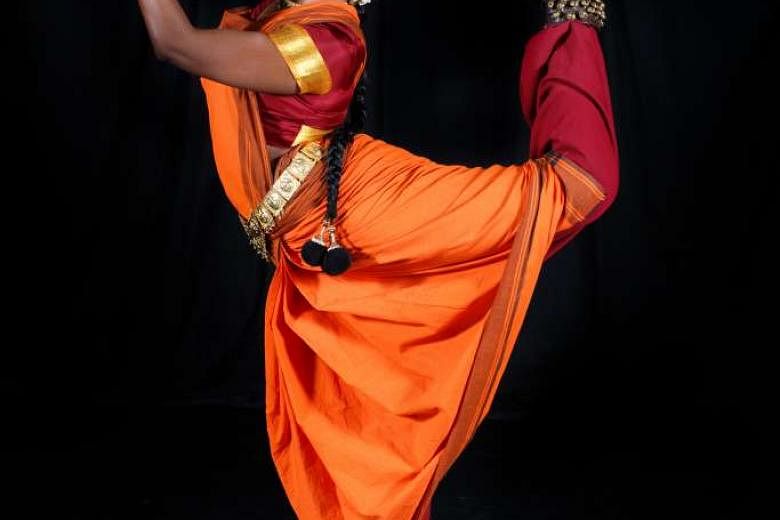On stage, bharatanatyam dancer Sarenniya Ramathas - one of the rising stars of long-standing Indian performing arts group Bhaskar's Arts Academy - is agile and confident.
But the 22-year-old, who is pursuing a degree in sociology at Nanyang Technological University, says: "I have massive stage fright and public speaking freaks me out. I don't think I really get over it as much as push through it.
"It helps that there is always a story to tell with bharatanatyam. I try to get into the mind of the character I'm playing so it isn't as intimidating."
She will perform on Saturday in Na Mah, a show that features two Indian classical dance forms - bharatanatyam and kathak.
How did you get into bharatanatyam and what made you fall in love with it? My mother made my sister and me join bharatanatyam classes when I was 10. She always wanted to learn bharatanatyam but never got the chance to.
I wasn't a big fan of dancing myself when I first started. I was more introverted and shy as a child, so dancing in front of a big group of people was terrifying.
-
BOOK IT /NA MAH
-
WHERE: Esplanade Theatre Studio, 1 Esplanade Drive
WHEN: Saturday,3 and 7.30pm
ADMISSION: $20 (matinee) and $25 (evening). Tickets available from Nrityalaya Aesthetics Society (call 6336-6537) or Bhaskar's Arts Academy(call 6396-4523). For more information, e-mail enquiries@bhaskarsarts.com
I think the turning point came when I was offered a role in a company production, Manohra, and I got to see how a big production is put together. I performed the smaller background roles, but I was in awe of the senior dancers who were like graceful celestial birds.
They moved so beautifully in unison. I knew someday I wanted to be able to dance the way they did.
I think it was around the same time that Mr Neewin Hershall, resident choreographer and performer at Bhaskar's Arts Academy, started teaching me. His teaching made all the difference to my attitude towards dance. I loved that I didn't have to try to be someone else in his classes. I just had to be the best version of myself.
What do you like most about bharatanatyam and what is most challenging to you? I love the challenge of putting a group of steps together and having to figure out how to make it flow from one step to another. That is why I like pieces that are faster and more physically challenging. I enjoy learning new techniques and learning different ways to move my body.
Facial expression is the most challenging for me. I think it's the hardest part of bharatanatyam to master and one requires a focused mind and complete involvement in the piece to achieve true expression.
What is the strangest or most memorable thing that has ever happened to you on stage? I think my most memorable moment on stage was getting to perform in front of the Ganges River in Patna, Bihar, in India.
The Ganges is considered the holiest river to Hindus, so performing the Ramayana, a Sanskrit epic poem, in front of it was such a blessing.
It was also pretty strange because the place we were performing at was by no means a proper auditorium. We had to perform on a concrete stage and there were no curtains or stage equipment.
What's the harshest criticism you have received and how did you deal with it? The harshest criticism I have ever received was that I was a mediocre dancer and that there was nothing special I had to offer.
That's the hardest thing for any artist to hear, I think, because that makes you extremely replaceable.
You also start to question your identity as a dancer and the chances you stand in an industry that values creativity. It took a long time for me to understand and accept that a few people's opinions are not representative of that of everyone.
However, I consider every criticism to be an opportunity to grow. I learnt to add my individuality to roles or dances I perform. Dance is a form of expression and I had to make sure my voice would be heard.
What are some misconceptions people might have about bharatanatyam? People think you have to be Indian to be able to appreciate or learn bharatanatyam. That's not true. I know so many exceptional bharatanatyam dancers who do not understand any Indian languages.
The stories we express through our dance were written ages ago, but the feelings and the morals behind them are relatable to everyone. Even the pieces we perform that do not tell a story are captivating because bharatanatyam uses dynamic movements, engaging every part of a dancer's body, from the eyes to the feet.
Most of all, bharatanatyam is a dance form that teaches respect - respect for your surroundings, for others and yourself. This is the concept that we will be exploring in our upcoming show, Na Mah.
The show will feature a well-rounded repertoire of bharatanatyam and kathak items so that the audience will get to experience the full beauty of Indian classical dances.


